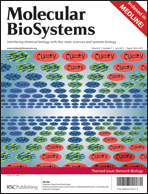Identification of calcium binding sites on calsequestrin 1 and their implications for polymerization†
Abstract
Biophysical studies have shown that each molecule of calsequestrin 1 (CASQ1) can bind about 70–80 Ca2+ ions. However, the nature of Ca2+-binding sites has not yet been fully characterized. In this study, we employed in silico approaches to identify the Ca2+ binding sites and to understand the molecular basis of CASQ1–Ca2+ recognition. We built the


 Please wait while we load your content...
Please wait while we load your content...